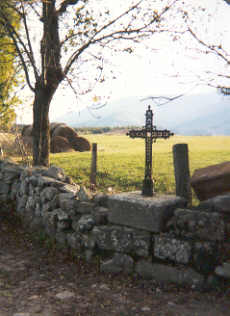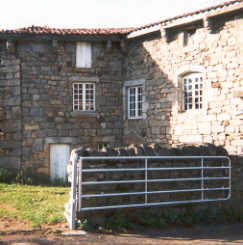GourmetFly.com
Massif Central
La lozère
Climate
June is the best month to start fly fishing in the Lozère.
As you can see on the river pictures shot the same day in September, the mornings can be quite cold with frost
on the grass, and the middle of the day quite hot if sunny. The reason is the altitude around 1000 meters, reaching
1300 meters at some places. |
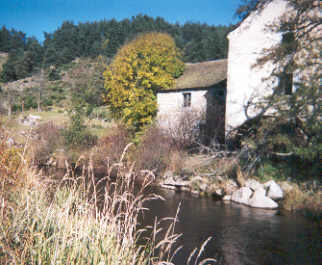
|
Landscapes
Simply beautiful and unspoiled. The traditionnal architectural is perfectly preserved and it is possible to admire
many old farms, barns, and watermills. This region is really heart touching. |
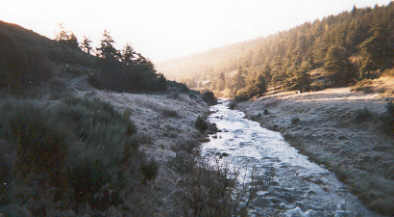
|
Fly Fishing
The choice of rivers is properly outstanding. There are brown peaty rivers on granite soils and deep blue
rivers and crystal clear others on limestone. All rivers are surrounded by impressive landscapes and host nice
populations of tough wild brown trouts. Fishing license around 40 euros. Guiding around 100 euros. |
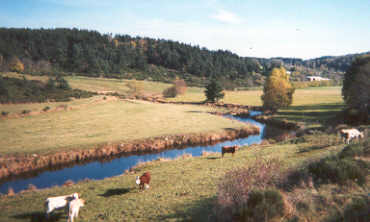
|
|
|
| |
|
|
Our choice of accomodations includes
-A- a highly wife endorsed but affordable hotel de luxe -B- a traditionnal countryside inn -C-
the perfect sportsman's inn, very cheap and ideally situated on one of the rivers.
Golfing can be arranged
Average price of a double room per night:
- A 90 euros - B 45 euros - C 30 euros -
|
Old stones
| Readings -
La Bête du Gévaudan - |
Beware of the beast....
We have mentionned in passing the names of the regions Margeride and Gévaudan. Many of the fishing streams
you will discover are inside these regions. Back in the years 1764-1767, the terrible story universally known as
the case of: La Bête du Gévaudan took place around here. It probably inspired Conan-Doyle for his
hound of the Baskerville, but it is a true story.
It began on the banks of the upper Allier around Luc or Labastide at a place you could choose for fishing. In June
1764, a young shepherdess tending cows was attacked by a monstrous beast that she later declared -could have been
a huge wolf but was something else... The cows saved the shepherdess, but she insisted on the fact that the beast
had attacked her and not the cows. At the end of June, a young girl disappeared near Langogne, then early August
another shepherdess was killed, while none of her sheeps were hurt. At the end of August a young boy was found
dead with horrible wounds, and the local administration eventually calls for huge battue in the Forêt de
Mercoire nearby. No outstanding beast was found and soon after a middle aged women was killed again at some distance
east near Châteauneuf de Randon. Villagers who came -too late- to rescue her recognized the description of
the beast by the shepherdess of Langogne who survived the first attack.
During the winter 1764-1765, the number of deadly attacks multiplied and expanded to the region of Aumont Aubrac.
A gigantic hunt is organized involving more than 10.000 men of the villages and local regiments of Dragoons. All
the local hunters are also present with their meutes of wolf hounds. No beast was found.
At the end of February 1765, Martin Denneval, best wolf hunter of the kingdom, with a record of 1.200 wolves on
his log arrived from Normandy. By the 30th of the month of May 1765, the number of attacks has reached 122 with
66 dead, and 40 mutilated victims. The king Louis XV is very upset that no one in the kingdom seems to be able
to stop such annoying disturbance and it is said that people are frankly laughing of the story in the neighbouring
courts of England and Prussia. Louis XV then sends his own royal louvetier, Grand-veneur Antoine de Beauterne.
In June, Denneval returned to Normandy -skunked- and convinced that the beast was not a -or at least not an ordinary-
wolf.
Indeed, some disconcerting facts are now part of the case. Some people have shot or hit the beast with all sorts
of blades, forks, spears and firearms and nothing showed any effect. More disturbing even was the fact that some
victims were found naked or head cut with hat replaced on it ! The story goes on unchanged from the beginning except
the slaughters had moved to the region of Saugues, near the Mount Mouchet. Nothing altered the number of attacks
or the misfortune of the hunters. But to the surprise of all on September 21st 1765, Antoine de Beauterne announced
he'd killed the beast somewhere farther in the monts du Velay, and takes the road back to Paris with his quarry
for the glory of our beloved king Louis XV. For the court the file was closed and the king truely happy. In Gévaudan,
though, people remain doubtful, but for two months there is no hint of a criminal beast in the region. Alas in
February 1766, a new series of victims was recorded. For Versailles, it is not the beast but this time normal inconveniences
caused by wolves and the locals were advised to cope with this problem alone -and do the favour to stop disturbing
the court with such insignificant troubles.
The murders continued until a young woman named Marie Denty was killed at la Besseyre. A man called Jean Chastel
who was the fiancé of Marie Denty, made three silver bullets out of a medal representing Mary mother of
the Christ, and after a priest had blessed the bullets, he joined the hunt given the next day on the mont Mouchet
-after the death of another young villager. He stayed far from the other shots on the eastern slopes of the mount
and kept his position sending prayers to the Virgin Mary. It is said that the beast came to him, sat down a few
feet in front of him and that the first shot killed the beast. The dead animal this time was recognized as THE
beast by those who had survived the attacks. No other explanation was given at this time and no other crime occured.
The clue to the whole story is purely the result of investigations made much later by scientists, hunters or historians.
At this time, no one was ever suspected for anything linked to the beast. Many people now believe that the Chastel
clan were keeping hideous dog-wolf hybrids for a cretin local aristocrat, Jean-François Charles de Morangiès
whose addiction was to kill kill savagely young girls or kids. Then apparently for some reason the beast escaped
from their control and also commited crimes on its own. The reason for its invulnerability could have been a cuirass
made of wild boar raw-hide. Some people said that after a fight the beast escaped with a large piece of bowel drifting
behind, but now it is thought that the bowels were in fact slings cut by one of the strikes. The epilogue would
be that the beast having killed the very fiancée of Jean Chastel he decided to put an end to all this. He
joined the next days hunt and stood away from the group. He called the beast and simply killed it when it came.
*



